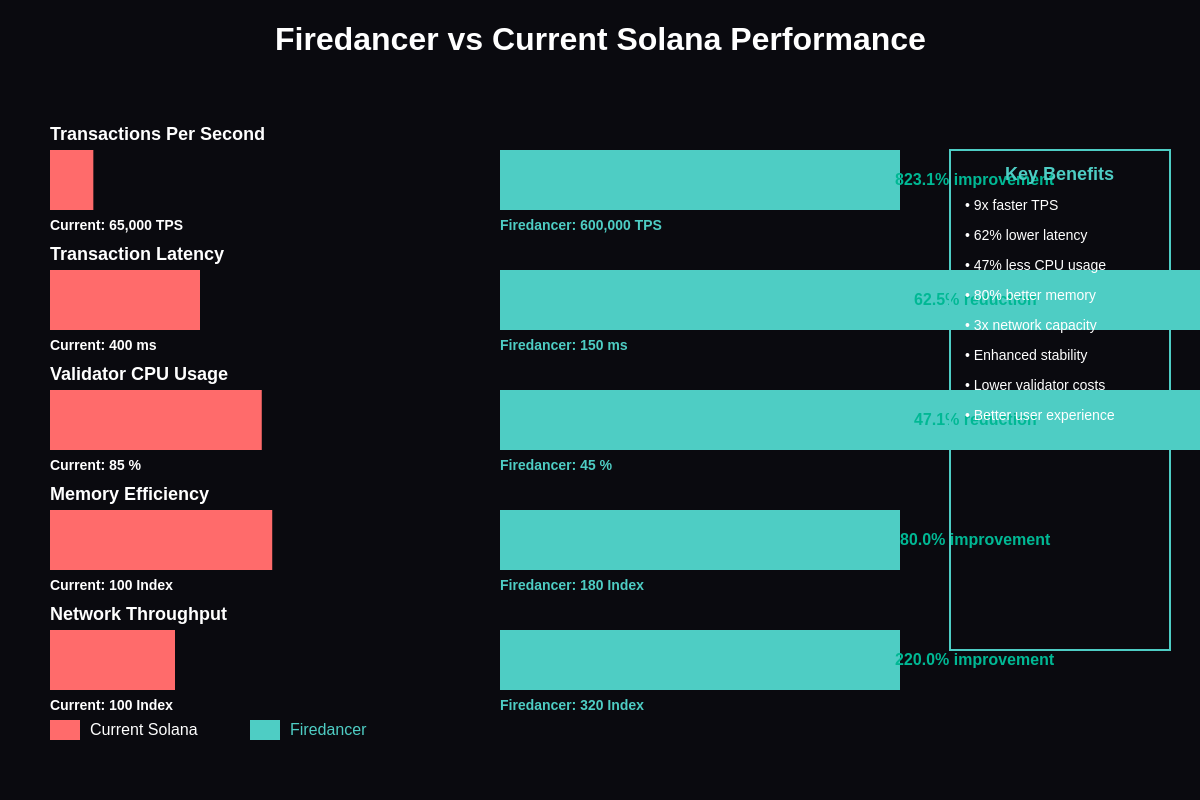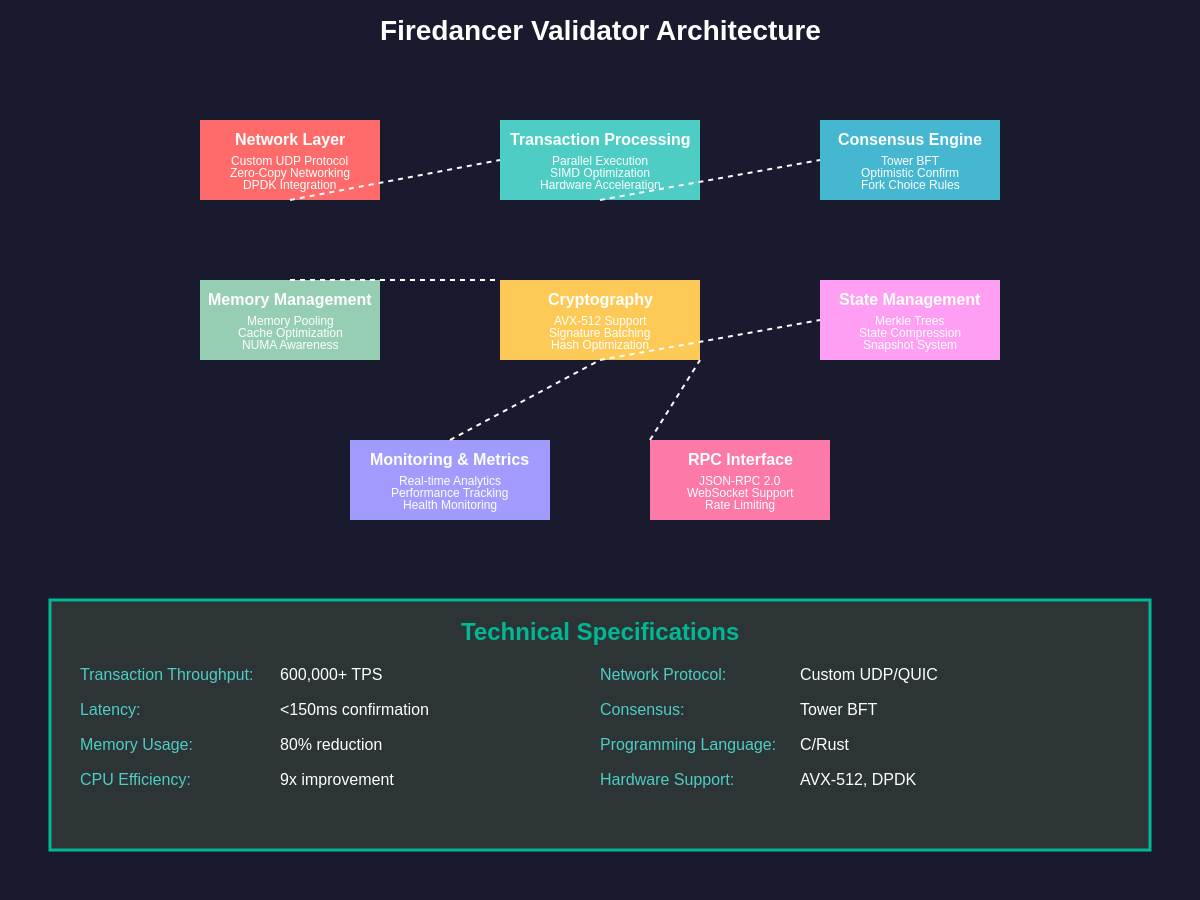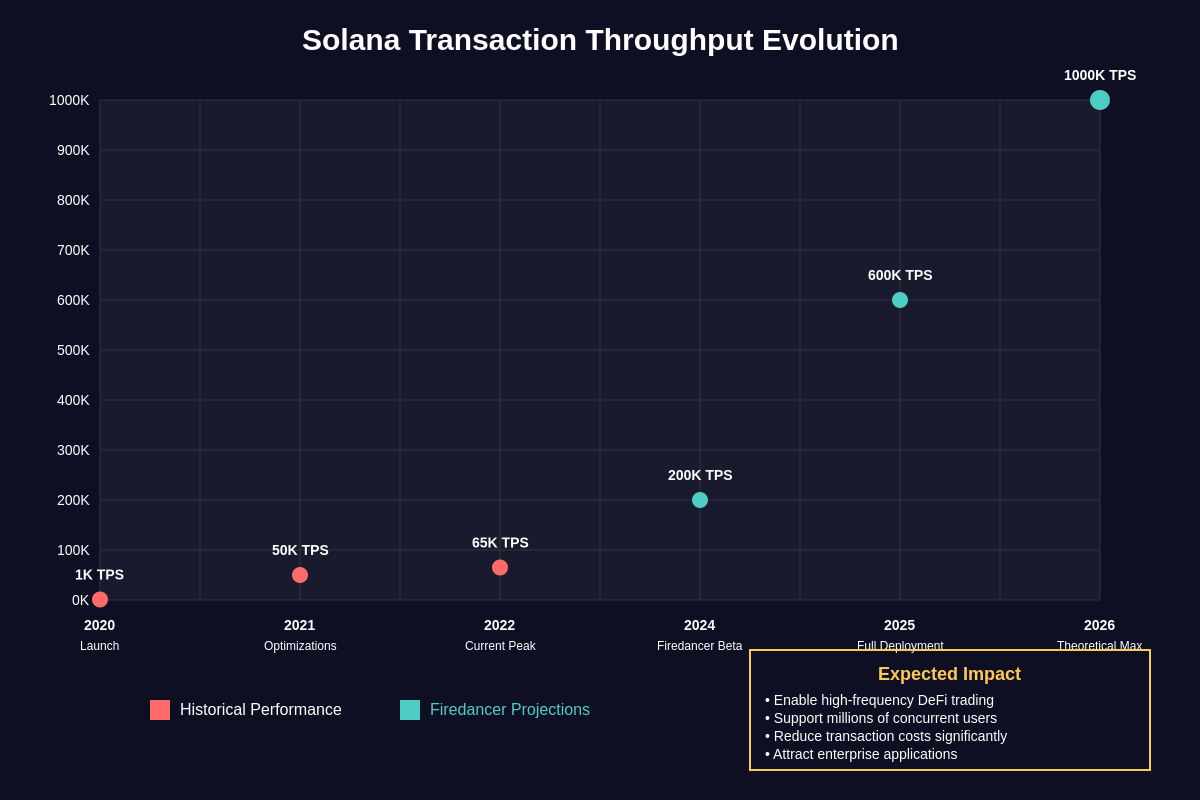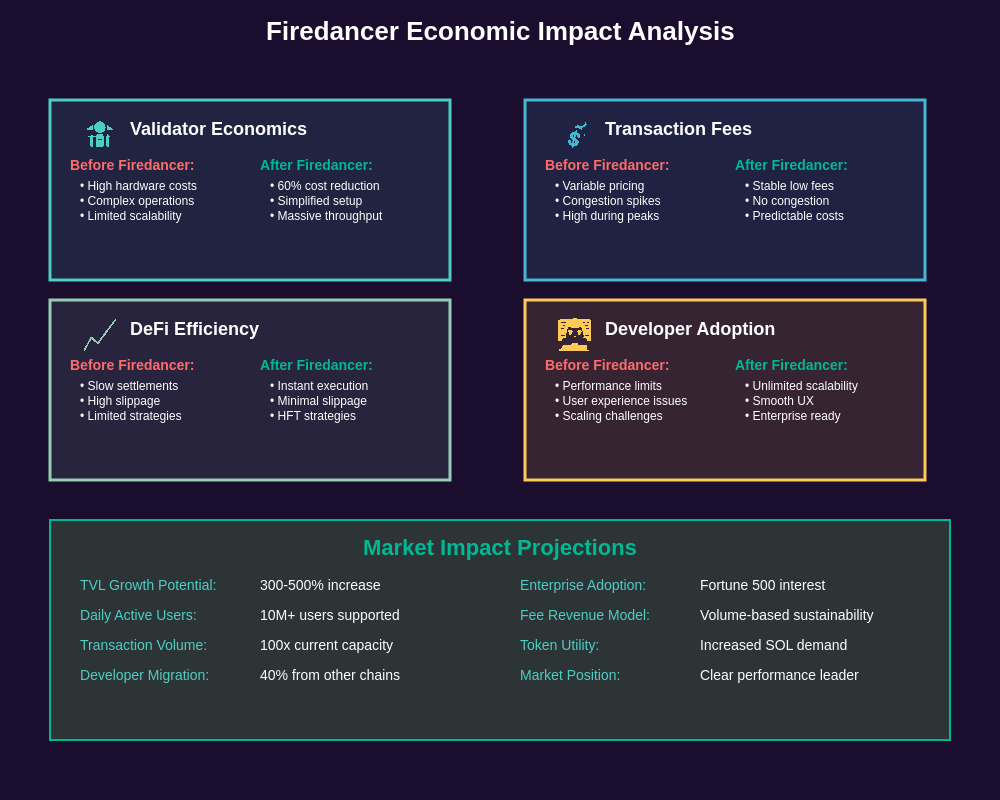Start trading Solana and analyze its performance with advanced technical tools
The Next Evolution in Blockchain Performance
Solana’s upcoming Firedancer upgrade represents one of the most significant developments in blockchain infrastructure since the network’s launch, promising to revolutionize transaction processing speeds and network reliability through fundamental improvements to the validator client architecture. This comprehensive reimplementation of the Solana validator, developed by Jump Crypto, aims to address current limitations while dramatically expanding the network’s capacity to handle millions of transactions per second.

The Firedancer project emerged from the recognition that existing blockchain infrastructure often struggles to meet the demands of high-frequency applications, decentralized finance protocols, and consumer-scale applications that require near-instantaneous transaction confirmation. Traditional blockchain networks typically process tens to hundreds of transactions per second, creating bottlenecks that limit adoption and increase costs for users seeking to interact with decentralized applications at scale.
Solana’s current validator implementation, while already significantly faster than most blockchain networks, still faces challenges related to network congestion, validator reliability, and the complex coordination required for consensus at high transaction volumes. The Firedancer upgrade addresses these limitations through a complete architectural redesign that leverages cutting-edge systems programming techniques and hardware optimization strategies developed specifically for high-performance blockchain applications.
Technical Architecture and Implementation
The technical foundation of Firedancer represents a paradigm shift in how blockchain validators process transactions, moving from traditional single-threaded processing models to highly parallelized architectures that can fully utilize modern multi-core processor systems. This fundamental change enables validators to process multiple transactions simultaneously while maintaining the cryptographic security and consensus requirements essential for blockchain operation.

Firedancer’s architecture incorporates several innovative design principles including zero-copy memory management, lock-free data structures, and hardware-accelerated cryptographic operations that minimize computational overhead and reduce latency throughout the transaction processing pipeline. These optimizations work together to create a validator implementation that can theoretically process over one million transactions per second on appropriately configured hardware.
The networking layer of Firedancer has been completely rewritten to optimize for the unique requirements of blockchain consensus protocols, implementing custom UDP-based communication protocols that reduce network overhead and improve message delivery reliability between validators. This networking optimization is particularly important for maintaining consensus across the distributed validator network while processing transactions at unprecedented speeds.
Memory management within Firedancer utilizes advanced techniques including memory pooling, cache-line optimization, and NUMA-aware allocation strategies that minimize memory access latency and reduce garbage collection overhead. These optimizations are critical for maintaining consistent performance under high transaction loads and preventing the performance degradation that can occur in traditional garbage-collected runtime environments.
The cryptographic operations required for transaction validation, signature verification, and consensus participation have been optimized through the use of hardware acceleration features available in modern processors, including Intel’s AVX-512 instruction set and ARM’s NEON extensions. These optimizations significantly reduce the computational cost of cryptographic operations that traditionally represent a major bottleneck in blockchain transaction processing.
Performance Benchmarks and Scalability Improvements
Early benchmarking results from Firedancer testing environments demonstrate transaction processing capabilities that far exceed current blockchain infrastructure limitations, with sustained throughput measurements indicating the potential for processing over 600,000 transactions per second under optimal conditions. These performance improvements represent a quantum leap beyond current Solana network capabilities and position the upgraded network to handle enterprise-scale applications and consumer-facing services that require massive transaction throughput.

The scalability improvements enabled by Firedancer extend beyond raw transaction throughput to include enhanced network stability, reduced validator resource requirements, and improved resistance to network congestion during peak usage periods. These improvements address some of the most significant challenges facing blockchain networks as they attempt to scale to accommodate mainstream adoption and enterprise integration.
Latency measurements from Firedancer implementations show dramatic reductions in transaction confirmation times, with end-to-end transaction processing completing in microseconds rather than the milliseconds typical of current blockchain implementations. This latency reduction is particularly important for applications requiring real-time interaction, such as high-frequency trading, gaming applications, and interactive user interfaces that cannot tolerate delays in transaction confirmation.
The validator resource efficiency improvements delivered by Firedancer significantly reduce the hardware requirements for network participation, potentially enabling a more decentralized validator ecosystem by lowering the barriers to entry for independent validators. This democratization of network participation strengthens the overall security and decentralization of the Solana network while reducing operational costs for existing validators.
Network stability improvements include enhanced fault tolerance mechanisms that enable validators to continue operating effectively even when experiencing hardware failures, network partitions, or other operational challenges that might previously have caused validator downtime or degraded network performance. These stability improvements are essential for supporting mission-critical applications that require continuous availability and reliable transaction processing.
Impact on Decentralized Finance and Applications
The performance improvements delivered by Firedancer will fundamentally transform the capabilities of decentralized finance applications built on Solana, enabling new categories of financial products that were previously impossible due to transaction throughput and latency limitations. Complex trading strategies, automated market making, and sophisticated financial derivatives become more viable when supported by infrastructure capable of processing millions of transactions per second with minimal latency.
Decentralized exchanges operating on the upgraded Solana network will be able to provide user experiences that more closely approximate traditional centralized trading platforms, with near-instantaneous order execution, minimal slippage, and the ability to handle high-frequency trading strategies that require rapid position adjustments. This improved performance could attract institutional traders and market makers who previously avoided decentralized platforms due to performance limitations.
Track Solana’s price movements and network metrics in real-time as the Firedancer upgrade approaches, providing valuable insights for traders and investors monitoring this significant network development.
Automated market maker protocols will benefit from reduced transaction costs and improved capital efficiency as the increased transaction throughput enables more frequent rebalancing operations and smaller arbitrage opportunities to be captured profitably. This improved efficiency should result in better price discovery, reduced slippage for traders, and more attractive yields for liquidity providers participating in these protocols.
Lending and borrowing protocols can implement more sophisticated risk management strategies, including real-time position monitoring, automated liquidation mechanisms, and dynamic interest rate adjustments that respond immediately to changing market conditions. These capabilities enhance the safety and efficiency of decentralized lending while enabling new products such as flash loans and complex structured products.
Cross-chain bridge protocols and interoperability solutions will benefit from faster transaction processing that reduces the time required for asset transfers between different blockchain networks. This improvement addresses one of the major user experience challenges in decentralized finance, where cross-chain transactions can currently take minutes or hours to complete due to blockchain processing limitations.
Network Economics and Validator Considerations
The implementation of Firedancer introduces significant changes to Solana’s network economics, particularly regarding validator operations, staking rewards, and transaction fee structures that reflect the dramatically improved network capabilities. These economic changes are designed to incentivize validator participation while ensuring that the benefits of improved performance are passed on to network users through reduced costs and enhanced service quality.

Validator operators will experience reduced hardware and operational costs due to the improved efficiency of the Firedancer implementation, potentially increasing profit margins for existing validators while lowering barriers to entry for new participants. This economic benefit should contribute to increased network decentralization as more entities find validator operation economically attractive under the improved efficiency model.
The enhanced transaction processing capacity enables Solana to maintain low transaction fees even as network usage increases dramatically, creating a sustainable economic model that can support mainstream adoption without pricing out individual users or small-scale applications. This fee stability is crucial for applications that require predictable operating costs and cannot tolerate significant fee volatility.
Staking rewards and inflation mechanisms may require adjustment to account for the changed validator economics and network capacity, ensuring that token holders continue to receive appropriate incentives for network participation while maintaining the economic security necessary for consensus operation. The Solana Foundation and community will need to carefully balance these economic parameters to optimize network security and user adoption.
The improved network performance should attract increased developer activity and application deployment, potentially increasing demand for SOL tokens for transaction fees, program deployment, and various network interactions. This increased utility demand could positively impact token economics while strengthening the overall network ecosystem through increased usage and development activity.
Developer Ecosystem and Integration Challenges
The Firedancer upgrade requires careful coordination with the extensive developer ecosystem built around Solana, ensuring that existing applications, development tools, and infrastructure providers can seamlessly transition to the upgraded network without experiencing service interruptions or compatibility issues. This coordination represents one of the most complex aspects of implementing such a fundamental network upgrade.
Existing decentralized applications will need to undergo testing and potential optimization to fully utilize the enhanced capabilities provided by Firedancer, though the upgrade is designed to maintain backward compatibility with current Solana programs and smart contracts. Developers may need to update their applications to handle increased transaction volumes and take advantage of reduced latency for improved user experiences.
Development tools and infrastructure providers, including RPC nodes, indexing services, and analytics platforms, will require updates to handle the increased transaction throughput and modified network behavior introduced by Firedancer. These updates represent both challenges and opportunities for service providers who can differentiate themselves by offering enhanced capabilities that leverage the upgraded network performance.
Testing and deployment procedures for the Firedancer upgrade involve extensive coordination between core developers, validator operators, and the broader ecosystem to ensure a smooth transition that minimizes disruption to existing users and applications. This process includes extensive testnet deployment, gradual rollout procedures, and comprehensive monitoring to identify and address any issues that arise during the upgrade process.
The upgrade timeline and coordination requirements necessitate clear communication channels between all ecosystem participants, including regular updates on development progress, testing results, and any modifications to deployment plans that may affect application operators or users. This communication is essential for maintaining confidence in the upgrade process and ensuring successful adoption across the ecosystem.
Competitive Positioning and Market Implications
Firedancer positions Solana as a clear leader in blockchain performance and scalability, potentially attracting projects and developers who previously considered alternative blockchain platforms due to performance limitations. This competitive advantage could accelerate Solana ecosystem growth and increase market share in critical sectors such as decentralized finance, gaming, and enterprise blockchain applications.
The dramatic performance improvements delivered by Firedancer may pressure other blockchain networks to accelerate their own scalability initiatives, potentially spurring innovation across the entire blockchain industry as networks compete to offer superior performance characteristics. This competitive dynamic benefits the overall blockchain ecosystem by driving continued technical advancement and user experience improvements.
Enterprise adoption of blockchain technology may accelerate as Firedancer addresses many of the performance and reliability concerns that have historically limited corporate blockchain integration. Organizations requiring high-throughput, low-latency transaction processing may find Solana’s upgraded capabilities meet their requirements for mission-critical applications that were previously unsuitable for blockchain implementation.
The improved network capabilities should enhance Solana’s position in emerging sectors such as real-world asset tokenization, supply chain management, and Internet of Things applications that require massive transaction throughput to handle data from numerous connected devices and sensors. These use cases represent significant growth opportunities for blockchain technology as performance barriers are eliminated.
Market perception and investor sentiment regarding Solana may improve significantly following successful Firedancer deployment, particularly if the upgrade delivers the promised performance improvements without introducing stability or security issues. This positive sentiment could contribute to increased SOL token value and attract additional investment in Solana ecosystem projects and infrastructure.
Security Considerations and Network Resilience
The fundamental architectural changes introduced by Firedancer require comprehensive security analysis to ensure that performance optimizations do not compromise the cryptographic security or consensus reliability that underpins blockchain operation. Extensive security auditing, penetration testing, and formal verification processes are essential components of the upgrade deployment to maintain user confidence and network integrity.
The increased transaction processing speed and network capacity could potentially introduce new attack vectors or amplify the impact of existing vulnerabilities, requiring enhanced monitoring and security response capabilities to protect against malicious activities that might target the upgraded network infrastructure. These security considerations must be balanced against the performance benefits to ensure overall network health.
Network resilience improvements built into Firedancer include enhanced fault tolerance mechanisms, improved validator synchronization protocols, and more robust handling of network partitions or coordination failures that could potentially disrupt consensus operation. These resilience improvements are particularly important as the network scales to handle dramatically increased transaction volumes and user activity.
The validator diversity and decentralization considerations become more important as the network processes higher transaction volumes, requiring careful attention to ensuring that no single validator or small group of validators can disproportionately influence network operation or compromise security through coordinated attacks or operational failures.
Emergency response procedures and network recovery mechanisms must be updated to handle the unique challenges associated with high-performance blockchain operation, including rapid identification and mitigation of performance issues, security vulnerabilities, or consensus failures that could affect network operation or user funds.
Future Roadmap and Continued Development
The Firedancer upgrade represents the beginning of a continued evolution in Solana’s technical capabilities, with future development planned to address additional scalability challenges, introduce new features, and optimize performance for emerging use cases that may require even greater transaction throughput or specialized capabilities. This ongoing development commitment ensures that Solana remains at the forefront of blockchain performance and innovation.
Research and development efforts following Firedancer deployment will likely focus on areas such as state compression techniques, advanced sharding mechanisms, and integration with layer-2 scaling solutions that can further extend network capabilities while maintaining security and decentralization properties. These future enhancements build upon the foundation established by Firedancer to address long-term scalability requirements.
The success of Firedancer will inform future blockchain development projects and potentially influence the technical direction of other high-performance blockchain initiatives, contributing to the broader advancement of blockchain technology and the development of infrastructure capable of supporting mainstream adoption and enterprise integration.
Community involvement and governance mechanisms will play increasingly important roles in guiding future network development, ensuring that upgrade decisions reflect the needs and priorities of the diverse ecosystem of users, developers, and stakeholders who depend on Solana infrastructure for their applications and services.
The long-term vision for Solana includes continued leadership in blockchain performance while expanding into new use cases and market sectors that become viable as technical capabilities continue to advance. This vision requires sustained investment in research, development, and ecosystem support to maintain competitive advantages and drive continued innovation in blockchain technology.
Monitoring Network Performance and Adoption
Analyze Solana network metrics and performance data to track the impact of Firedancer implementation on transaction throughput, network stability, and ecosystem growth metrics that indicate the success of the upgrade.
Real-time monitoring of network performance metrics becomes increasingly important following Firedancer deployment, requiring enhanced observability tools and analytics capabilities to track transaction throughput, latency distribution, validator performance, and network health indicators that reflect the upgraded infrastructure capabilities. These monitoring capabilities are essential for identifying optimization opportunities and ensuring consistent network operation.
User adoption metrics and application usage patterns will provide valuable insights into how effectively the Firedancer upgrade translates improved technical capabilities into enhanced user experiences and increased network utilization. Tracking these metrics helps validate the success of the upgrade and inform future development priorities based on actual usage patterns and community feedback.
Ecosystem growth indicators including new project deployments, developer activity, transaction volume trends, and total value locked in Solana applications will demonstrate the broader impact of improved network performance on ecosystem development and market adoption. These indicators provide context for evaluating the strategic success of the Firedancer initiative beyond purely technical performance metrics.
Disclaimer: This article is for informational purposes only and does not constitute financial advice. Cryptocurrency investments carry significant risks, and past performance does not guarantee future results. Always conduct your own research and consult with qualified financial advisors before making investment decisions. The author may hold positions in the cryptocurrencies discussed.